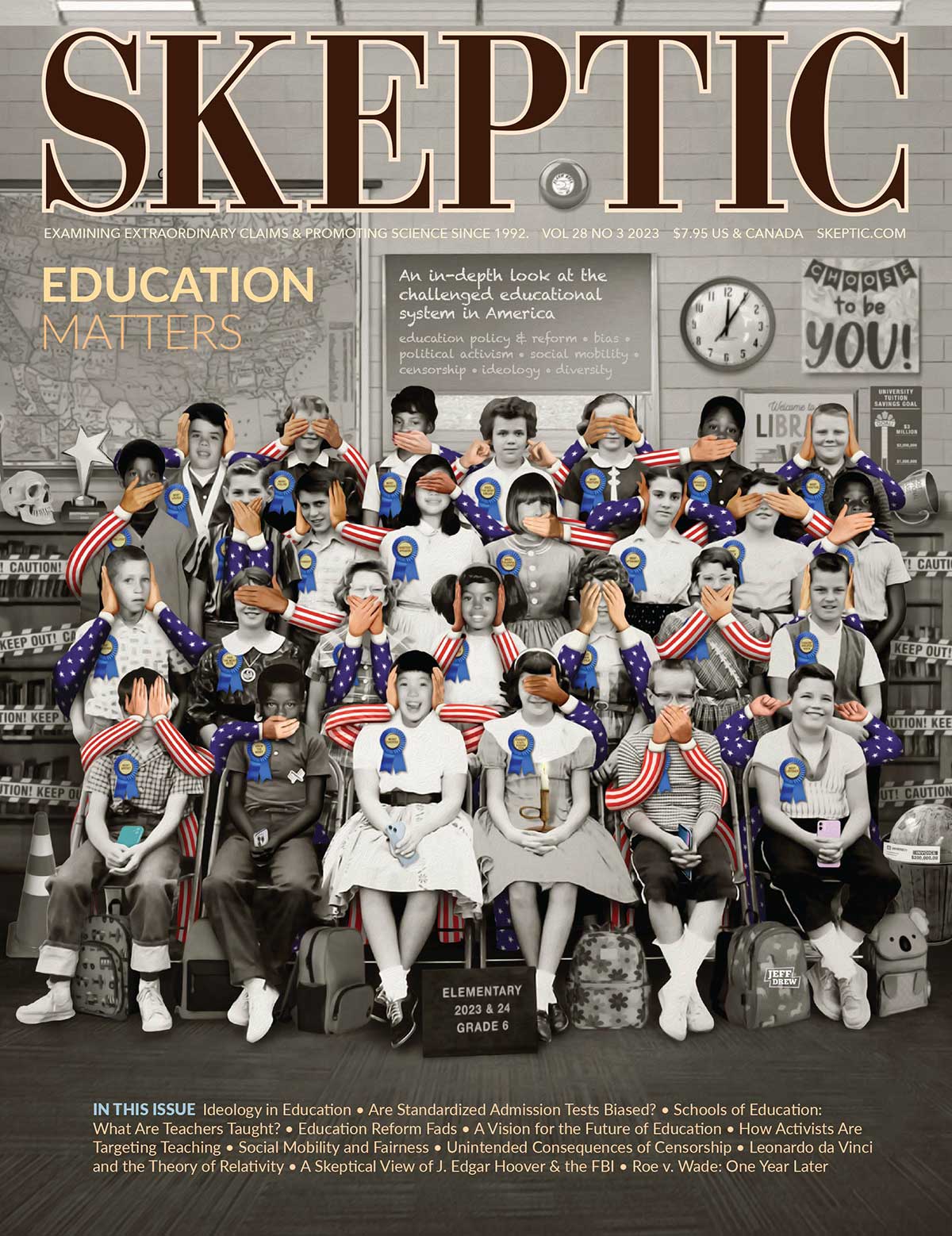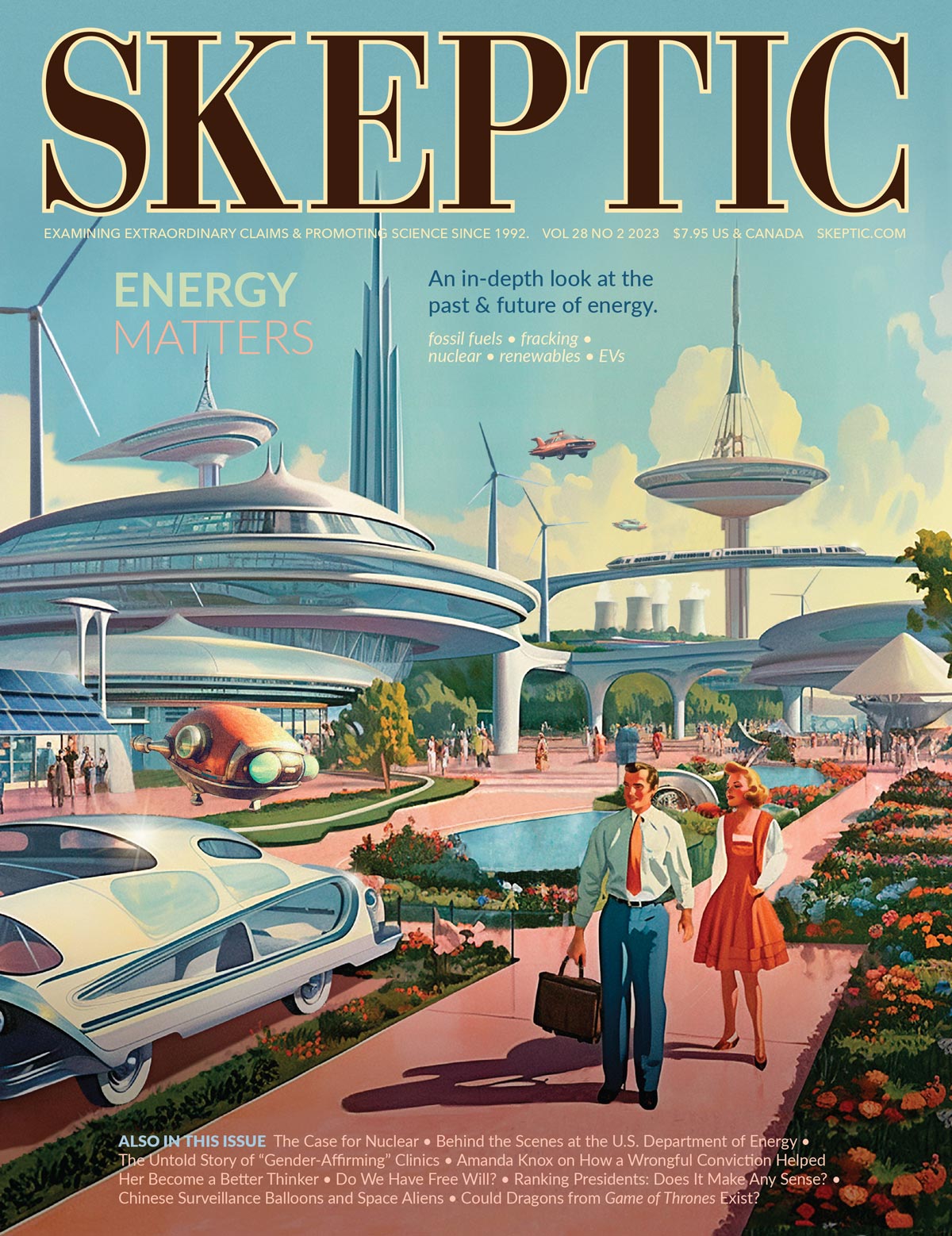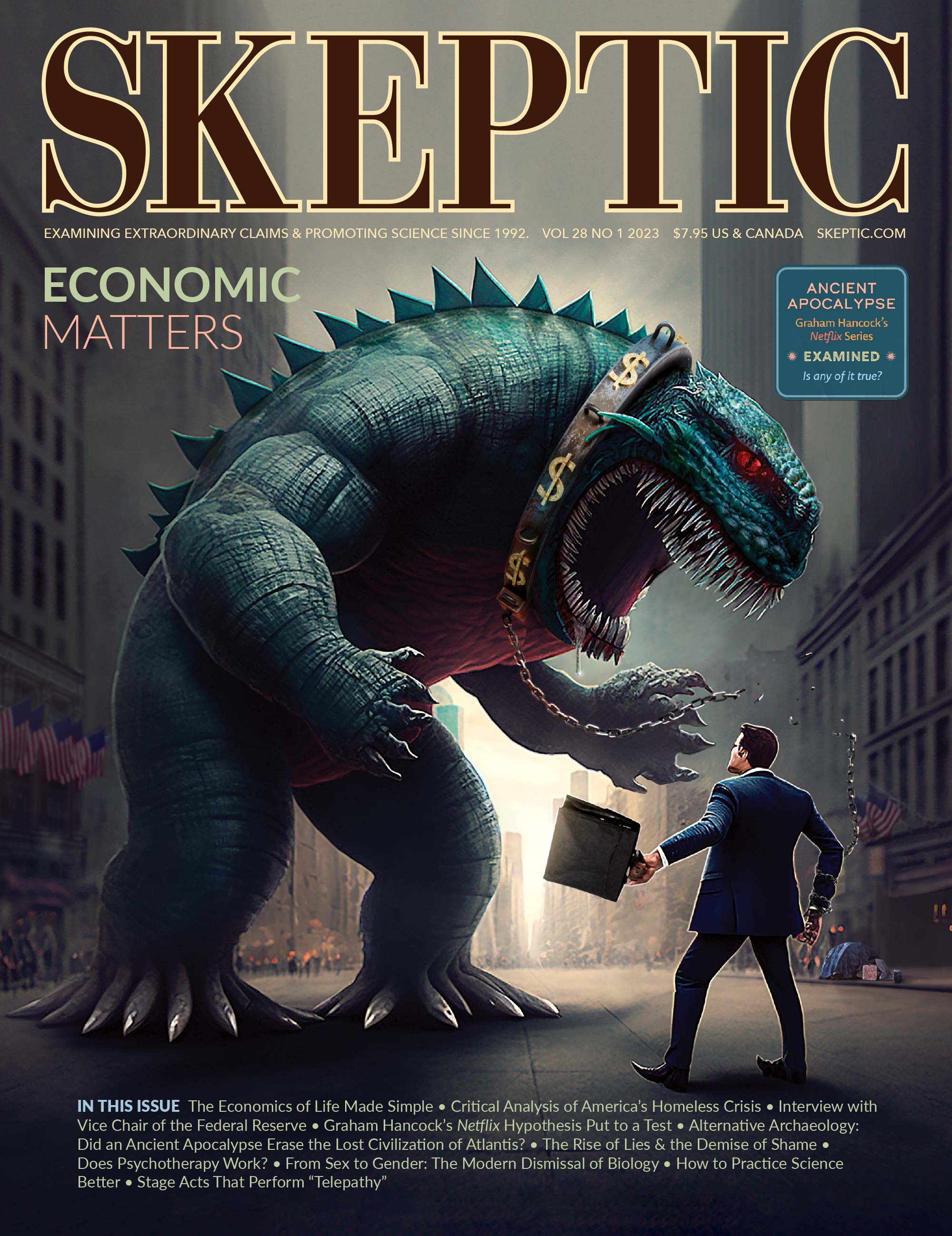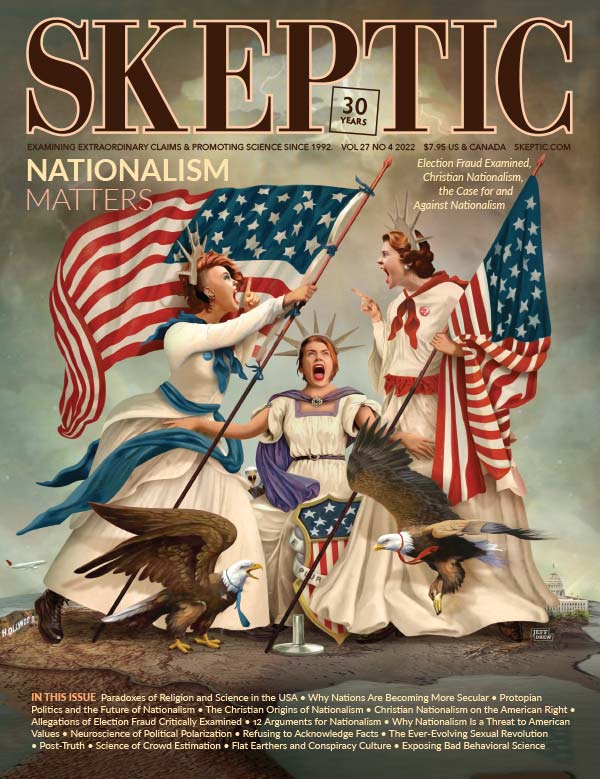This week’s eSkeptic features an announcement for Michael Shermer’s upcoming weekend workshop at the Esalen Institute, Science, Spirituality & the Search for Meaning, followed by James N. Gardener’s review of Conflict in the Cosmos: Fred Hoyle’s Life in Science, a biography by Simon Mitton, published by Joseph Henry Press, ISBN 0309093139.

the Esalen Institute, Big Sur, California (photo by Angela Smith)
Science, Spirituality & the Search for Meaning
a weekend seminar led by Michael Shermer
August 12th, 8:30pm to August 14th, 11:30am
at the Esalen Institute, Big Sur, CA
The intellectual and spiritual quest to understand the universe and our place in it is at the core of both science and religion. At the beginning of the 20th century social scientists predicted that belief in God would decrease by the end of the century because of the secularization of society. In fact, the opposite happened. Never in history have so many, and such a high percentage of the population, believed in God and expressed spirituality. To find out why, science historian and social scientist Dr. Michael Shermer has undertaken a monumental study of science, spirituality, and the search for meaning through his numerous writings, presented here for the first time in workshop format.
Since humans are storytelling animals, a deeper aspect of this issue involves the origins and purposes of myth and religion in human history and culture. Why is there is an eternal return of certain mythic themes in religion, such as messiah myths, flood myths, creation myths, destruction myths, redemption myths, and end of the world myths? What do these recurring themes tell us about the workings of the human mind and culture? What can we learn from these myths beyond the moral homilies offered in their narratives? What can we glean about ourselves as we gaze into these mythic mirrors of our souls?
Humans are not only storytelling animals, we are also pattern-seeking animals, and there is a tendency to find pattern even when none exists. To most of us the pattern of the universe indicates design. For countless millennia we have taken these patterns and constructed stories about how our cosmos was designed specifically for us. For the past few centuries, however, science has presented us with a viable alternative in which we are but one among tens of millions of species, housed on but one planet among many orbiting an ordinary solar system, itself one among possibly billions of solar systems in an ordinary galaxy, located in a cluster of galaxies not so different than billions of other galaxy clusters, themselves whirling away from one another in an expanding cosmic bubble that very possibly is only one among a near infinite number of bubble universes. Is it really possible that this entire cosmological multiverse exists for one tiny subgroup of a single species on one planet in a lone galaxy in that solitary bubble universe? In this workshop, we will explore the deepest question of all: what if the universe and the world were not created for us by an intelligent designer, and instead is just one of those things that happened? Can we discover meaning in this apparently meaningless universe? Can we still find the sacred in this age of science? The answer is yes!
about the Esalen Institute
Esalen is, geographically speaking, a literal cliff, hanging precariously over the Pacific Ocean. The Esselen Indians used the hot mineral springs here as healing baths for centuries before European settlers arrived. Today the place is adorned with a host of lush organic gardens, mountain streams, a cliff-side swimming pool, hot springs embedded in a multimillion-dollar stone, cement, and steel spa, and meditation huts tucked away in the trees. Esalen was founded in 1962 by Stanford graduates Michael Murphy and Richard Price and has featured such notable visitors as Richard Feynman, Abraham Maslow, Timothy Leary, Paul Tillich, Carlos Castaneda, and B. F. Skinner. Regardless of your source of spirituality (science, religion, or self), Esalen embodies the integration of body, mind, and spirit.
about the seminar leader
Dr. Michael Shermer is the Founding Publisher of Skeptic magazine, the Director of the Skeptics Society, a monthly columnist for Scientific American, the host of the Skeptics Lecture Series at the California Institute of Technology (Caltech), and the co-host and producer of the 13-hour Fox Family television series, Exploring the Unknown.
He is the author of Science Friction: Where the Known Meets the Unknown, about how the mind works and how thinking goes wrong. His book The Science of Good and Evil: Why People Cheat, Gossip, Share Care, and Follow the Golden Rule, is on the evolutionary origins of morality and how to be good without God. He wrote a biography, In Darwin‚s Shadow, about the life and science of the co-discoverer of natural selection, Alfred Russel Wallace. He also wrote The Borderlands of Science, about the fuzzy land between science and pseudoscience, and Denying History, on Holocaust denial and other forms of pseudohistory. His book How We Believe: Science, Skepticism, and the Search for God, presents his theory on the origins of religion and why people believe in God. He is also the author of Why People Believe Weird Things on pseudoscience, superstitions, and other confusions of our time.
According to the late Stephen Jay Gould (from his Foreword to Why People Believe Weird Things):
Michael Shermer, as head of one of America‚s leading skeptic organizations, and as a powerful activist and essayist in the service of this operational form of reason, is an important figure in American public life.
Dr. Shermer received his B.A. in psychology from Pepperdine University, M.A. in experimental psychology from California State University, Fullerton, and his Ph.D. in the history of science from Claremont Graduate University. Since his creation of the Skeptics Society, Skeptic magazine, and the Skeptics Distinguished Lecture Series at Caltech, he has appeared on such shows as 20/20, Dateline, Charlie Rose, Larry King Live, Tom Snyder, Donahue, Oprah, Leeza, Unsolved Mysteries, and other shows as a skeptic of weird and extraordinary claims, as well as interviews in countless documentaries aired on PBS, A&E, Discovery, The History Channel, The Science Channel, and The Learning Channel.
registration
$595, which includes the workshop, housing, and meals at one of the most beautiful locations in the world. Register for the seminar through the Esalen Institute, (not through the Skeptics Society).
(831) 667-3038 (programs)(831) 667-3005 (reservations)
[email protected]
www.esalen.org
The Big Bang’s Steady State
The Life & Science of Fred Hoyle
a book review by James N. Gardner
The vast scale of the cosmos confounds our imagination.
What human mind — calibrated by natural selection to appreciate intuitively the dimensions of African savannahs, primeval arboreal hideaways, and Ice Age mammoth hunting grounds — can truly grasp its fathomless enormity? Billions of galaxies, each containing hundreds of billions of stars, those stars probably orbited by trillions of planets, and the entire fabric of spacetime expanding outward like the surface of an inflating balloon — this is the surpassingly strange picture of our universe that constitutes the consensus paradigm of modern cosmology.
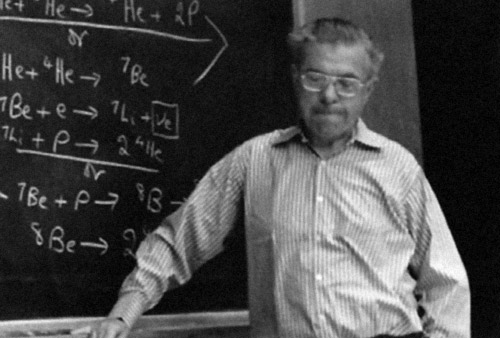
Fred Hoyle lecturing on solar neutrinos at Rice University, 1975.
(photo courtesy of Clemson University and Donald D. Clayton)
That vision is centered on the premise of a Big Bang — a primordial explosion that launched the whole shebang hurtling outward at breakneck speed — which seems, from a commonsense perspective, perfectly outrageous. What came before the Big Bang, we wonder? What caused this peculiar genesis event? Could the cosmos really have been born ex nihilo, for no apparent reason and from the loins of nothing at all?
These were the puzzles that led a giant of British astronomy — Fred Hoyle — to suggest a dramatic alternative: the steady-state theory, which hypothesized that the universe is eternal and ever-expanding and that the cosmic storehouse of matter is constantly replenished through a process of continuous creation. As Simon Mitton demonstrates in this superb new biography of Hoyle, the great scientist’s genius lay in his ability to resist the temptation to surrender to mainstream orthodoxy. While Hoyle’s cosmological theory may have turned out to have been spectacularly wrong (more on this below), what cannot be denied is that his stubborn unwillingness to bow to conventional wisdom was a valuable intellectual asset that benefited the entire scientific community. As Mitton puts it:
Hoyle’s personal contribution to the rebirth of British astronomy came from his outstanding ability to think outside the box … An enduring feature of Hoyle’s character was that in every sense he never let setbacks, rejections, or political maneuvers deflect him from his research agenda. He always had a deep conviction that in his “search for the truth,” which is how he expressed his life’s mission, any opponent should be able to provide a counterargument from experiment or direct observation. He declined all opposition based on semantic arguments invoking the philosophy of science, or the deployment of a paradigm, or appeals to common sense.
Iconoclasm and catholicity of scientific interest were the two key markers of Hoyle’s long and conflict-laden life. As astrophysicist Owen Gingerich observes in a thoughtful foreword to Conflict in the Cosmos, these characteristics — deeply rooted in Hoyle’s hard-scrabble background — were both his greatest strength and the source of his ultimate undoing:
Fred Hoyle was the quintessential outsider, entering Emmanuel College Cambridge from an impoverished family background and with a distinct Yorkshire accent, and leaving Cambridge in a misguided huff 39 years later. But in between he ascended into the highest ranks of British science, almost single-handedly returning Britain to the top echelons of international theoretical astrophysics and setting it on the path toward excellence in observational astronomy. It is a stirring Dickensian story of an inquisitive, rough-hewn lad making the grade in the tightly traditional world of Cantabrigian academia, yet with the depths of a Greek tragedy where the flawed hero finally becomes an outcast.
The 39-year interregnum was the central chapter in the scientist’s life — a tumultuous period characterized by heroic accomplishment, intense controversy, and an extraordinary level of celebrity, which Hoyle achieved both as a popular BBC commentator and as a highly successful science fiction writer. As Mitton points out:
After 1950, Fred Hoyle was a very public figure at home and abroad … His broadcasts for the BBC in 1950 were just extraordinary and brought him immediate fame as a gifted expositor. With his gritty Yorkshire manner, his ability to be picturesque using words alone, and the universe as his topic, he transformed the BBC’s approach to academic lectures, persuading them of the benefits of a less donnish style of presentation. His lectures for radio audiences set the prelude for a brilliant parallel career as a popular science and science fiction writer … In science fiction, his first novel, The Black Cloud, remains his best, having now acquired cult status: In 2004, an opinion poll conducted by the British newspaper The Guardian to find the most accomplished science fiction writers placed Hoyle in third position!
Hoyle is remembered most vividly for the idea about which he was famously mistaken: that the universe exists in a steady state, with the stockpile of atoms in an eternally expanding cosmos continuously refilled by the constant creation of new matter. Normally, falsified scientific hypotheses like the steady-state conjecture are tossed unceremoniously in the dustbin of intellectual history, serving at best as amusing footnotes to the main body of orthodox theory (think of Darwin’s misplaced reliance on Lamarckism as a subsidiary engine of evolution in The Origin of Species). But, once again, Hoyle confounds tradition. Because he was both passionate and brutally honest about the implications of his steady-state hypothesis, Hoyle was able to foment a heated intellectual debate that significantly advanced our understanding of the universe, despite the fact that his particular conjecture turned out to be deeply flawed. As Mitton notes, “What is extraordinary about Fred Hoyle’s science is that his impact derives equally from when he was right and when he was wrong!”
If Hoyle was wrong about the nature of the process of cosmogenesis, he was spectacularly right about an equally profound mystery: the origin of the chemical elements. In what is surely his most important contribution to astrophysics, Hoyle and three collaborators were able to demonstrate rigorously in their famous B2FH scientific paper that all of the elements of the periodic table except the lightest are forged in the hearts of giant supernovae, under a variety of physical conditions, through a process known as nucleosynthesis. It is this process of stellar alchemy, Hoyle and his colleagues showed, that accounts for the richness and complexity of the chemical palette of the universe, which in turn accounts for the possibility of life.
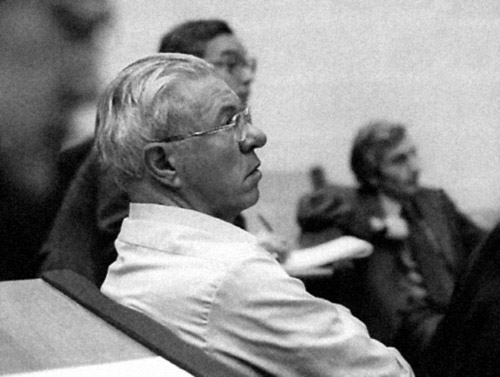
Fred Hoyle in the New Cavendish Lecture Hall, listening to a speaker, 1981.
(photo courtesy of Clemson University and Donald D. Clayton)
In the midst of this monumental accomplishment, Hoyle stumbled across a deep mystery that eventually lured him away from the shoreline of genuine science out onto the trackless sea of metaphysical speculation: the apparent fine-tuning of nature evidenced by the details of the process through which the element carbon is synthesized.
This discovery provoked Hoyle’s most controversial conjecture: the notion that the universe appeared to be deliberately fine-tuned to favor the emergence of carbon-based life. As Hoyle wrote late in his life:
The issue of whether the universe is purposive is an ultimate question that is at the back of everybody’s mind … And Dr. [Ruth Nanda] Ashen has now raised exactly the same question as to whether the universe is a product of thought. And I have to say that that is also my personal opinion, but I can’t back it up by too much of precise argument. There are many aspects of the universe where you either have to say there have been monstrous coincidences, which there might have been, or, alternatively, there is a purposive scenario to which the universe conforms.
The debate over this portentous issue rages on to this day, fueled by the recent discovery of the monstrously large landscape of alternate versions of low-energy physics mathematically allowed by M-theory, only a tiny fraction of which would permit the emergence of anything resembling our own universe and of carbon-based life. Indeed, that discovery has lead many cutting-edge cosmologists to overlay a refinement of Big Bang inflation theory called eternal chaotic inflation with an explanatory approach that has been traditionally reviled by most scientists known as the weak anthropic principle. (The weak anthropic principle merely states in tautological fashion that since human observers inhabit this particular universe, it must perforce be life-friendly or it would not contain any observers resembling ourselves.) Eternal chaotic inflation, invented by Russian-born physicist Andrei Linde, asserts that instead of just one Big Bang there are, always have been, and always will be, an infinite multiplicity of Big Bangs going off in inaccessible regions all the time. These Big Bangs create a vast horde of new universes constantly and the whole ensemble constitutes a multiverse.
One gets the uneasy feeling that if this current theorizing turns out to be correct, Fred Hoyle may have been on the right track all along! Perhaps the multiverse is eternal. Perhaps there is a process of continuous creation (a.k.a. eternal chaotic inflation) as opposed to a one-off genesis event (i.e., a single Big Bang).
Maybe the only thing Fred Hoyle truly failed to grasp was the sheer, unexpected grandeur of steady-state cosmogenesis. Hoyle believed that the continuous-creation process yielded “no more than one atom in the course of a year in a volume equal to St. Paul’s Cathedral.” This is an image of a natural process comfortably within the confines of our biologically evolved human imagination.
But if Linde and his colleagues are correct, the process of continuous creation operates at a scale utterly beyond our capacity to physically envision it — not mere atoms but entire new baby universes are continuously created in an eternal process with striking parallels to Hoyle’s discarded steady-state cosmological theory.






